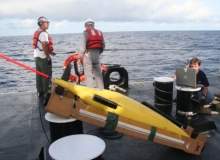
With territorial disputes in the Asia-Pacific region and piracy off the coast of Somalia continuing to be a thorn in the side of seafarers, attention has once again shifted towards littoral waters and, more importantly, technology designed specifically to protect them.
Recent industry reports have asserted that many obstacles are posed in defending littoral waters, not least with piracy due to the vast expense of mobilising a destroyer or frigate in order to protect a vessel from a skiff and a handful of pirates. The international maritime laws and rules of engagement also strongly dictate the control and use of weapons at sea, ruling out the use of particular unmanned sea vessels (USVs) to engage pirates.

Discover B2B Marketing That Performs
Combine business intelligence and editorial excellence to reach engaged professionals across 36 leading media platforms.
What has emerged, however, is the use of USVs or their underwater counterparts – unmanned underwater vessels (UUVs) – hunt mines and provide of intelligence, surveillance and reconnaissance.
UUV usability
Shallow water craft such as riverine UUVs have been deployed in many combat zones, serving purposes that other craft are unable to and are too dangerous to be carried out by divers. Riverine UUVs have catered for a particular operational requirement in the disposal of underwater mines and were explicitly used as part of Operation Iraqi Freedom.
US Naval Special Clearance Team One, in collaboration with Royal Navy and Australian counterparts, was tasked with exploratory mine-hunting and clearance in the waters surrounding ports off of Umm Qasr, as well as rivers around Az Zubayr and Karbala. Dealing with obstacles including tidal extremes, low tides and strong water currents, the UUVs were used in order to identify and remove mines, gain an insight into the littoral waters for strategic use and to aid mapping of the waters.

US Tariffs are shifting - will you react or anticipate?
Don’t let policy changes catch you off guard. Stay proactive with real-time data and expert analysis.
By GlobalDataAs a result, the ports were rendered safe to use, allowing humanitarian aid to be shipped in and data recovered was shared with the Port and Maritime Registry in order to help in future dredging missions.
Masked mine-hunting
At this year’s Defence and Security Equipment International (DSEi) exhibition, Atlas Elektronik unveiled its ‘Cobra’ explosive ordnance disposal attachment for the company’s successful SeaFox UUV, enabling mine disposal without significantly risking the reusability of vehicles.
The attachment acts as a mask for the vehicle and attaches itself to the mine as the vehicle moves the mine to a safe distance and location. The mask is then disposed of with the mine, rendering it a cheaper option than potentially risking the use of the UUV in order to move and dispose of the mine.
The Cobra attachment can be fixed to the SeaFox either through nail attachment units, a harpoon for use on soft-skin targets or magnetic grabs and is designed to be used at depths of up to 300m.
SeaGlider gets enhanced
US-based robotics firm iRobot has responded to renewed competition in the UUV market by enhancing its SeaGlider vehicle, increasing its capabilities by improving the vehicle’s payload capabilities.
The long-range, high-endurance UUV can operate at depths between 20m and 1,000m, and was the first UUV to complete a nine-month mission without the need for a battery change.
It is now fitted with larger fairings in order to increase the vessel’s volume and mass payload, which has been doubled to 4kg in comparison to the previous design.
Payload volume has also been boosted by 650%, allowing the integration of more and larger sensors. The vehicle now comes with five sensor payload ports, supporting a wide range of sensors. A radiation sensor, echo sounder and current profiler are also in development.
Littoral-capable missiles
Although long-range, submarine-launched ballistic missiles like Russia’s jointly-developed Bulava have risen to prominence, the development of other missiles has perhaps taken a backseat. In September 2011, Kongsberg commenced deliveries of its Naval Strike Missile, fulfilling a contract signed with Norwegian Defence Logistics Organisation in June 2007.
The missiles, fitted to operate aboard Norway’s Fridtjof Nansen-class frigates and Skjold-class strike craft, are designed to operate effectively in littoral environments as well as in open waters, appealing to the nation’s defence requirements. The anti-ship, sea-skimming missiles possess the ability to penetrate shipboard defences whilst remaining stealth and high manoeuvrable and have a range in excess of 200km.
Stopping pirates in their tracks
The rise of piracy, particularly off the coast of the Horn of Africa and Somalia, has given weight to an increasing amount of technology designed to combat such a threat. BAE systems unveiled its anti-piracy laser system in early 2011, capable of temporarily blinding or ‘dazzling’ any potential pirates to ward off attacks. At DSEi 2011, UK-based BCB International unveiled its Sea Stinger device as a similarly non-lethal form of deterrent.
The device acts in a similar fashion to the ‘stinger’ strip more commonly used by police to stop a fleeing vehicle, rendering pirate skiffs immovable. It consists of a compressed-air cannon that can be attached to a ship’s bridge, which launches a floating entanglement projectile towards the vessel.
The projectile surrounds the vessel and wraps itself around the propeller, leaving pirates stranded in the ocean. Operating at pressures of up to 1,000 PSI, the projectile can reach speeds of up to 350m/s. Alternatively, the Sea Stinger can also deploy buoyancy aids or smoke for screening or marking.
BCB International marine projects officer Jonathan Delf said, "Piracy is a problem that has dogged shipping companies for several years. In actual fact the problem is getting worse. The Maritime Industry is slowly realising that it needs to cast its net wider and start looking at new piracy protection technologies that do not place their vessels and crews under any further unnecessary risk. We believe that our compressed air anti-piracy launchers like the Sea Stinger ticks all the boxes."





